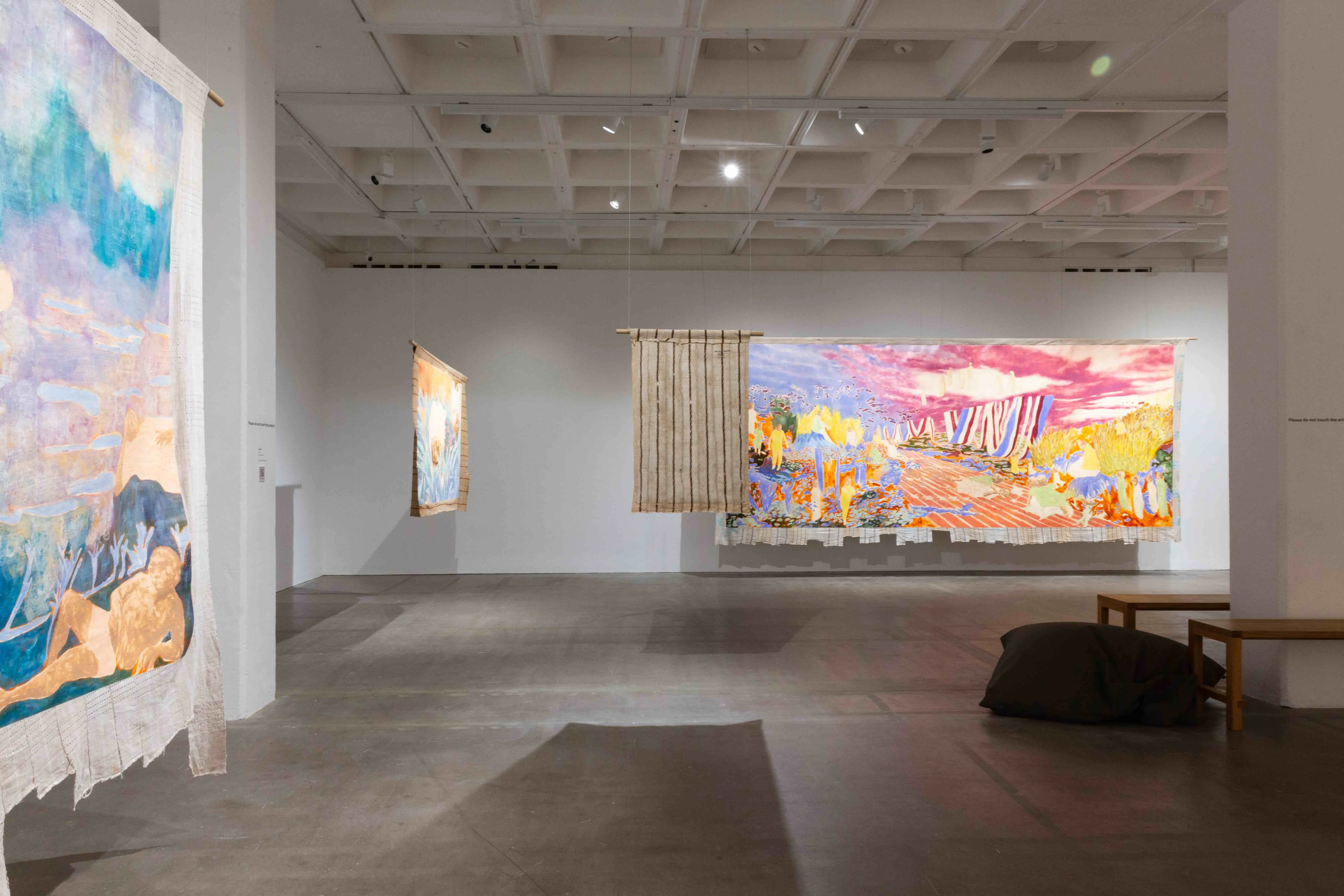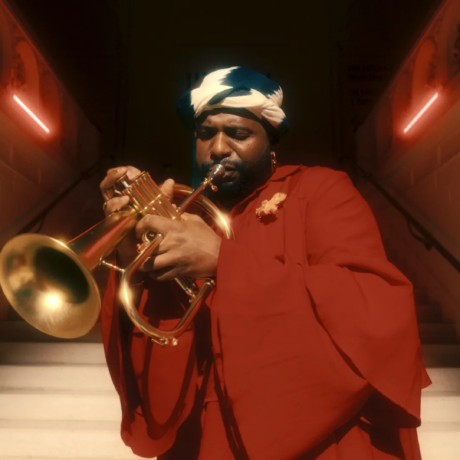Almost half a century after FESTAC, Nigeria’s artistic landscape is ever-more dynamic and vibrant, revealing a fusion of its rich history, community, and unyielding resilience. Below, Amber Smith reflects on the moments that stood out in Nigerian art in 2024.

Held in Lagos’s Tafawa Balewa Square in 1977, the Second Festival of Black Arts and Culture (hereafter FESTAC) is now recognised as a critical point in the development of a Black global consciousness. Bringing together artists from around Africa and the diaspora, it formed a platform for the construction of a cultural empowerment and preservation strategy. Almost 50 years later, the spirit and legacy of FESTAC lives on through the continued evolution and preservation of Nigerian art and culture; from the highly anticipated pavilion at the Venice Biennale, to numerous emerging and underserved artists’ international exhibitions, to the opening of the Museum of West African Art (MOWAA), this article surveys a snippet of the expansive talent and creative endeavours of the Nigerian art scene in 2024.

The Lagos Biennale
Showcasing the works of eighty artists from thirty countries, the fourth edition of the Lagos Biennale brought together explorations of the theme ‘Refuge’ that offered ‘alternate paths towards constructing renewable communities’ and worked towards ecological justice. According to Artistic Directors Folakunle Oshun and Kathryn Weir, the biennial provided an opportunity to reconsider ‘the promises, disappointments, and ongoing ramifications’ of current systems of governance within the context of global capitalism its crises.
Exhibiting the biennial in FESTAC’s original location was a meaningful homage, presenting a vast and ambitious challenge embraced by both local legends and emerging talents. The renowned Bruce Onobrakpeya’s towering Stonehenge-like sculptures, crafted from auto parts, beads, and bone, marked the entrance to the main exhibition space.
Victor Ehikhamenor’s Miracle Central (2024) created an immersive dialogue on the intersecting histories of religion and culture in Nigeria. ‘The work was a meditation on the hallowed space to be found at the intersections of religion, politics, history, and expressions of belonging,’ Ehikhamenor noted. The installation featured a makeshift evangelist worship tent, fully adorned in white handkerchiefs—said to reference the Nigerian Pentecostal movement—along with stained glass windows, ominously suspended chairs and instruments, and a central rosary tapestry altar bearing the message ‘EXPECT A MIRACLE’ while Gospel music set the tone.
Traces of Ecstasy, a collaborative pavilion curated by K. J. Abudu, engaged with Tafawa Balewa Square’s role in postcolonial nation-building as a point of departure. The pavilion featured a healing sculptural sound work by Evan Ifakoya that reflected on the migration of spiritual practices across the Black Atlantic. It was presented alongside a video installation by Temitayo Shonibare which revisited the #EndSARS movement against police brutality that occurred across Nigeria in 2020, blending raw, found visuals and audio from the protests.

ART X Lagos
The ninth edition of ART X Lagos, West Africa’s leading international art fair, unfolded this autumn under the theme of ‘Promised Lands.’ It catalysed conversations about both real and imagined spaces that symbolise hope and envision greater freedoms, prompting critical reflections on the aspirations of Africa and its diaspora. This edition featured notable galleries including kó (Layo Bright, Mobolaji Ogunrosoye, Ngozi Ezema-Omeje), Nike Art Gallery (Bruce Onobrakpeya, Nike Okundaye, Rufus Ogundele), Alexis Galleries (Dominique Zinkpe, Francis Agemo, Kingsley Ayogu, Stanley Arinze), O’DA (Abe Odedina), and Affinity Art Gallery (Damilola Onosowobo, Shannon Bono, Vanessa Endeley) among others.
ART X Lagos also boasted an ambitious programme of experiences spanning music, film, design, and art. Some of these events centred the continent and diaspora’s exceptional talent, with keynote artists and speakers including El Anatsui, Njideka Akunyili-Crosby, Yinka Shonibare CBE, and more. Others prompted audience participation, such as the newly introduced Speakers’ Corner: The Crossroads, a space for ART X Lagos visitors to share their journeys and reflections.
The exhibition Mark-Makers: Unsung Pioneers formed another part of the programme, honouring extraordinary yet historically overlooked Nigerians, from Jonathan Adagogo Green, Nigeria’s first professional photographer, to visionaries like Nana Asma’u, who revolutionized women’s education. Curated by Missla Libsekal, this exhibition celebrated figures who redefined what was possible for Africans in science, art, and social activism.
La Biennale di Venezia
At the sixtieth edition of La Biennale di Venezia, Nigeria’s much-anticipated second pavilion presented ‘a restless investigation of the legacies of the colonial past and a defiant imagining of a hopeful, youth-driven future.’ Employing an intergenerational and, at times, a diasporic lens, Nigeria Imaginary was a dynamic showcase featuring revered contemporary Nigerian artists: Tunji Adeniyi-Jones, Ndidi Dike, Onyeka Igwe, Toyin Ojih Odutola, Abraham Oghobase, Precious Okoyomon, Yinka Shonibare CBE RA, and Fatimah Tuggar. Each expanded their practice in scale and materiality to explore ‘the role of great moments in Nigeria’s history—moments of optimism—as well as the Nigeria that lives in our minds: a Nigeria that could be and is yet to be.’ As noted by Aindrea Emelife, the pavilion’s curator, the works functioned almost like ‘like points in a manifesto.’
This vision was realised by ambitious works, such as a living installation in the courtyard by mixed-media artist, poet, and chef Precious Okoyomon. Re-Sky/Emit Light: Yes, Like That (2024) featured a gleaming orb radio tower reflecting the surrounding brick and foliage, delicately strung bells that reacted to the wind, rain, and atmosphere, as well as an electronic synthesizer reconfiguring the sounds of Venice. This environmental music intertwined with broadcasted words of select Nigerian poets, artists, and writers, providing a meditative pause in daily realities and encouraging, according to the artist, ‘a moment of collective cultural thinking.’

Ndidi Dike presented Blackhood: A Living Archive (2024), a towering, monolith-like sculpture comprised of a large steel frame, rope, and seven hundred and thirty-six wooden police batons—which were in effect during Nigeria’s colonial and post-colonial era—nestled within the structure. They were made all the heavier by the attached brown paper cadaver tags, inscribed with the names of recently deceased Nigerians, African-Americans, and Afro-Brazilians. The work served as a confronting call to action and a memorial of hope against the enduring violence of police.
Yinka Shonibare CBE RA’s work, Monument To The Restitution Of The Mind And Soul (2023), acted as a journey through time; each level of the amassing pyramid spelled out the intricate layers of history of Nigeria’s artistic production. The artist ‘imagines a future where the majestic, historic artworks that were looted by British forces from the Kingdom of Benin are displayed not as trophies of a lost, immutable past, but as testaments to sophistication and ever-changing artistic innovation.’ An essential addition to this work was a bronze bust of Sir Harry Rawson, encapsulated in a vitrine and painted in Shonibare’s signature Batik-style pattern. Rawson, who led the punitive Benin Expedition of 1897, is emblematic of figures whose destructive actions remain insufficiently acknowledged and unaccounted for.
The Museum of West African Art
Recently opened in November this year, the encyclopaedic Museum of West African Art (hereafter MOWAA) aims to deepen connections between global contemporary art and the rich cultural heritage of West Africa, creating opportunities for African and diasporic artists and scholars. The museum’s goal, as stated by art historian and curator Aindrea Emelife, is to be ‘a blueprint, a convening point, and the centre of outreach that helps grow and sustain museum infrastructure throughout West Africa.’ MOWAA is engaging with the living culture of Nigeria—its artisans and local and regional museums—while forging meaningful relationships and partnerships with museums globally.
Contemporary galleries and art spaces

Expanding on the continued momentum of the Nigerian artistic landscape, many artists and galleries from the region have experienced defining moments this year. O’DA, a contemporary art gallery in Lagos established by Obida Obioha, bridges local and international audiences and supports artists who explore themes of identity, technology, political commentary, social consciousness, and environmental change. This year, they presented Within our Midst, a duo exhibition featuring Michael Igwe and Paul Majek, which explored the potential of art to reveal connections between generations and spirituality and questioned how often socio-cultural beliefs and normalities are reflected upon.
kó is an art space in Lagos that is focused on championing leading Nigerian artists from the modern period, and celebrating emerging and established contemporary artists across Africa and its diaspora. One of the gallery’s many notable exhibitions this year is the group show Kindred Spirits: A Gathering of the Aka Circle of Artists, which features the work of fifteen artists from the renowned Aka Circle, a pioneering force in Nigeria’s contemporary art scene between the 1986 and 2000. Another is Matters of Essence II, a group exhibition that explored the significance of materiality and the tangibility of creative expression, featuring work by Mimi Adu-Serwaah, Sika Amakye, Elfreda Dali, Nwakuso Edozien, Christopher, Samuel Idowu, and Omolade Ogundimu.
Wunika Mukan Gallery, established in 2020 by Wunika Mukan, nurtures emerging artists from Nigeria, Sub-Saharan Africa, and the diaspora. In ART SALON: CHIJIOKE ANYACH, vibrant and evocative works by Nigerian artist Chijioke Anyacho captured deconstructed moments in time, reflecting on the burdens of everyday reality, loss, and sacrifice. The group show OUR STUCK TOGETHER PIECES celebrated the beauty that arises when contrasting states intertwine: the liminal and balanced spaces between solitude and connection, individuality and unity, and desires and realities that define human experience. It featured the work of Tshepiso Moropa, Daniel Oruwhone, Edward Ofosu, Patricia Renee Thomas, Lakin Ogunbanwo, Tyler Williams, Joseph Obanubi, Yadichinma Ukoha-Kalu, and Ikeorah Chisom Chi-FADA.

Founded by Adenrele Sonariwo with galleries in Nigeria, London, and Los Angeles, Rele promotes and supports artists and cultural practitioners from across the African continent, diasporic communities, and beyond. This year, the gallery has showcased the work of Nigerian artists in standout exhibitions, such as Peju Alatise’s We Came With The Last Rain, a profound artistic endeavour centred around the empowering narrative of the girl-child, providing a glimpse into a larger theme that the artist has been nurturing over her years in London. Additionally, Woven Sanctuaries, a group exhibition of seven female artists from across Africa which together documented the complex personal and social landscapes that textiles make possible; here, the materials were the message. How to Hold a Moonbeam; How Do You Hold Memory?, IyunOla Sanya’s second solo exhibition with the gallery, explored the sculptural possibilities of paint and emotive qualities of colour in obscure silhouettes of human experiences in Lagos.

Artists
Widely regarded as a defining figure in Nigerian modernism, Bruce Onobrakpeya was a pioneer of using bronzed lino relief and metal foil deep etching to explore Nigerian folklore and contemporary life. This summer, he opened his second major retrospective in the United States, The Mask and the Cross, at the Smithsonian’s National Museum of African Art, following its premiere at the High Museum of Art in Atlanta last year.
Nengi Omuku, known for expressive paintings depicting abstract figures set against celestial landscapes on Nigerian sanyan fabric, opened her highly-anticipated debut solo exhibition this autumn. Wild Things and Perennials at Kasmin Gallery in New York City coincided with her first museum show, The Dance of the People and the Natural World, at Arnolfini in Bristol.
Chicago-based, Lagos-born artist Luke Chidiebube Agada presented Between Two Suns at Roberts Projects, Los Angeles. His recent paintings feature surreal and spectral shadows, using colours inspired by Lagos to convey themes of displacement and selfhood with dreamlike ambiguity.
Lastly—but certainly not least—ceramics artist, poet, and historian Ozioma Onuzulike was selected as a finalist for the Loewe Foundation Craft Prize for his ceramic work. His monumental beaded tapestries pay homage to West African textile styles, as well as reflecting on the symbolic resonance of clay and the colonial legacy of beads within the broader context of Africa’s socio-political and economic upheavals.
Written by Amber Smith





